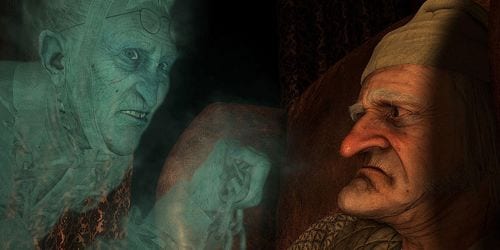
If watching goony-faced animatronic creatures cowering in terror or delivering Christmas cheer as if with a cudgel is your idea of a good time, then Disney’s A Christmas Carol should be right up your alley. (Those who enjoy virtual roller-coaster rides and long falls from high places are also encouraged to attend.)
Once upon a pre-millennial time, Robert Zemeckis made movies with real people in them. They might not have been the stuff of undying classics, but in his post-Forrest Gump phase, he directed a number of films — Contact, What Lies Beneath, and Cast Away — that made a good case for Hollywood still being able to produce broad-minded and reasonably intelligent adult dramas. Since then, though, with his feature-length experiments in performance-capture animation, Zemeckis has trudged further and further down the path of making films as “experiences” rather than stories. It’s as though Spielberg had decided during the 1990s to devote himself entirely to creating video games and new rides at Universal Studios.
The Zemeckis of old would have been a good choice to reanimate Dickens’ chestnut. In addition to his imprint as a family-friendly blockbuster director, he also has had a long-running sideline in producing, and occasionally writing or directing, genre horror. It would seem a perfect mix, given that A Christmas Carol is as much a ghost story as it is a tale of holiday joy. At film’s start, Zemeckis zooms in on the book’s ghoulish opening line (“Marley was dead: to begin with…”) and even adds in a nice bit whereby the old miser Ebenezer Scrooge, after reluctantly coughing up the funds for burying his old business partner, nabs the coins off the corpse’s eyes, while noting, “Tuppence is tuppence.”
The film takes glee in laying out the extent of Scrooge’s enmity toward the rest of humanity, following the original story’s dialogue surprisingly closely for the most part. Played by Jim Carrey as a hunched and muttering spectre, Scrooge harasses his unlucky sole employee, Bob Cratchit (Gary Oldman), for wanting Christmas day off (“A poor excuse for picking a man’s pocket every 25th of December!”), berates his nephew (Colin Firth) for being married, and suggests that “every idiot” who goes around wishing Merry Christmas should end up buried “with a stake of holly through his heart.”
All well and good, given how efficiently Zemeckis’ script mines Dickens’ half-comical tone for its best gems. Nobody would call it particularly complex, but there’s a reason it’s brought back in different incarnations year after year. The tale articulates a primal fear of wasting one’s life that is nothing if not universal. And many of Zemeckis’ cartoon flourishes, from Carrey’s humbug scowling to the graveyard horror of Scrooge’s encounter with the Ghost of Christmas Yet to Come, make perfect sense in this context. It’s a simple morality tale, ginned up with special effects in order to more thoroughly punch home the message of repent now or die a miserable death.
But the special effects of A Christmas Carol soon go awry. The combination of animation (where the laws of physics are conveniently suspended) and 3D technology is a powerful temptation, and here we see many of the ways in which those toys can be misued. Scrooge’a visitations by the three ghosts (all voiced by him, and not with any particular distinction) are the real meat, as they allow him a look at his own history and the horrible end he’ll suffer for his stinginess, and also giving the audience a hint of how he turned so rotten.
But it’s also an excuse for Zemeckis to send Scrooge hurtling through a seemingly endless series of rides and chases, hanging on to one ghost as it zooms through a snowy wood, or running down a dark alley as he’s being chased by another. By the time the film is done with these 3D thrills, it shows little interest in Scrooge’s human encounters.
The problem here is not just one of unnecessary gimmickry. There is also the inability of the performance-capture animation to render convincingly any more than the most basic sort of emoting; it’s as though the actors — who include heavyweights like Fionnula Flanagan and Bob Hoskins — are speaking through ill-fitting masks. With the exception of Scrooge, whose every grimace is finely detailed, most of these round-faced Londoners are drawn with the kind of bulbous crudity of Shrek.
All this means that when Scrooge at last realizes his folly, it’s difficult to empathize: his belated holiday cheer feels too forced by half. And by this time next year, when the Christmas Carol theme ride is up and running at Disney World, such carping will seem mostly beside the point.

![Call for Papers: All Things Reconsidered [MUSIC] May-August 2024](https://www.popmatters.com/wp-content/uploads/2024/04/all-things-reconsidered-call-music-may-2024-720x380.jpg)



